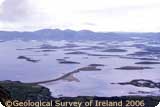conférence sur la glaciation Quaternaire en Irlande – jeudi 17 septembre 2009
The sedimentological and geophysical anatomy of the ‘Pigeon Point’-drumlin, Clew Bay, Ireland – Clues about mechanisms of drumlin formation and regional ice flow patterns
John F. Hiemstra, université de Swansea, Pays de Galles
jeudi 17 septembre 2009, à 13 heures
Glacial sedimentary products (such as e.g. drumlins and moraines) shape much of the landscape in the UK and Ireland, and have been subject to intensive sedimentological and palaeoglaciological research for some time. Glacial sedimentary products are fundamentally important since they hold the key to former responses of glaciers and ice sheets to climatic forcing. Understanding such responses is prerequisite to reliable calibration of ice sheet models seeking to identify present and predict future ice mass responses to global warming. It is therefore not surprising that ship-borne seismic imaging of submerged glacial sedimentary sequences around the present margins of the world’s ice sheets and ice caps is widely used in palaeoglaciological research. In contrast, it is very surprising that geophysical techniques are rarely used in the investigation of land-based glacial sedimentary products.
In this study, we combine sedimentological and geophysical techniques to look into the mechanisms responsible for the formation of the Pigeon Point drumlin in Clew Bay, Co. Mayo, Ireland. While the primary aim of the study is to contribute to the understanding of the mechanisms responsible for the formation of drumlins in general, a secondary aim is to shed light on the still heavily discussed reconstruction of Late Quaternary glacial dynamics and ice flow patterns in this part of Ireland.
- kc_data:
- a:8:{i:0;s:0:"";s:4:"mode";s:0:"";s:3:"css";s:0:"";s:9:"max_width";s:0:"";s:7:"classes";s:0:"";s:9:"thumbnail";s:0:"";s:9:"collapsed";s:0:"";s:9:"optimized";s:0:"";}
- kc_raw_content:
The sedimentological and geophysical anatomy of the 'Pigeon Point'-drumlin, Clew Bay, Ireland - Clues about mechanisms of drumlin formation and regional ice flow patterns
John F. Hiemstra, université de Swansea, Pays de Galles
jeudi 17 septembre 2009, à 13 heures

Glacial sedimentary products (such as e.g. drumlins and moraines) shape much of the landscape in the UK and Ireland, and have been subject to intensive sedimentological and palaeoglaciological research for some time. Glacial sedimentary products are fundamentally important since they hold the key to former responses of glaciers and ice sheets to climatic forcing. Understanding such responses is prerequisite to reliable calibration of ice sheet models seeking to identify present and predict future ice mass responses to global warming. It is therefore not surprising that ship-borne seismic imaging of submerged glacial sedimentary sequences around the present margins of the world’s ice sheets and ice caps is widely used in palaeoglaciological research. In contrast, it is very surprising that geophysical techniques are rarely used in the investigation of land-based glacial sedimentary products.
In this study, we combine sedimentological and geophysical techniques to look into the mechanisms responsible for the formation of the Pigeon Point drumlin in Clew Bay, Co. Mayo, Ireland. While the primary aim of the study is to contribute to the understanding of the mechanisms responsible for the formation of drumlins in general, a secondary aim is to shed light on the still heavily discussed reconstruction of Late Quaternary glacial dynamics and ice flow patterns in this part of Ireland.
- extrait:
- lien_externe:
- titre:
- The sedimentological and geophysical anatomy of the 'Pigeon Point'-drumlin, Clew Bay, Ireland - Clues about mechanisms of drumlin formation and regional ice flow patterns
- intervenant:
- John F. Hiemstra
- date:
- jeudi 17 septembre 2009
